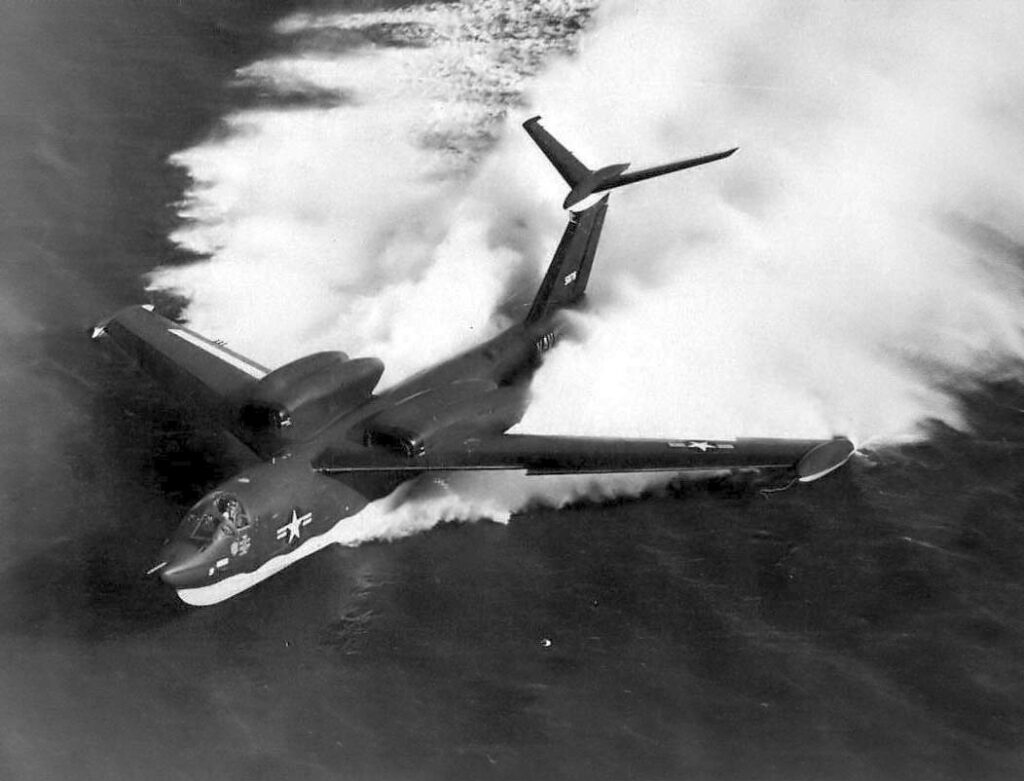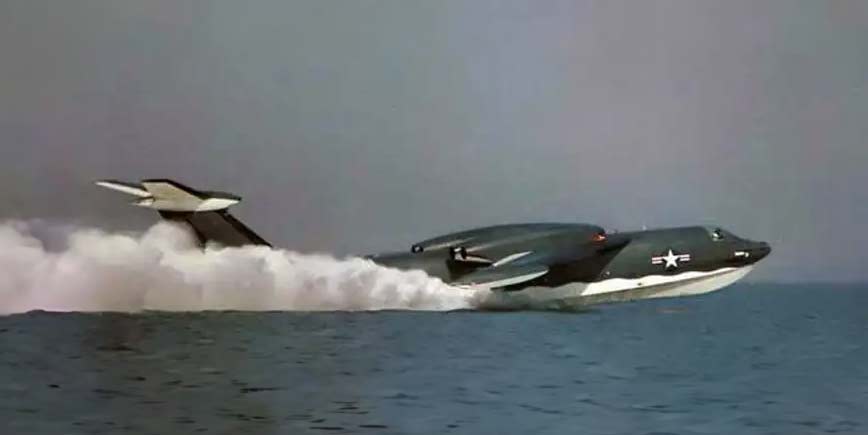The Martin P6M SeaMaster, a strategic bomber flying boat, designed for minelaying and reconnaissance with nuclear strike capability.
In brief
The Martin P6M SeaMaster, built by the Glenn L. Martin Company, was a jet-powered flying boat designed primarily for long-range minelaying and reconnaissance missions, with a secondary nuclear strike capability. Developed in the 1950s for the U.S. Navy, the SeaMaster embodied cutting-edge technology of its time, including turbojet engines mounted atop the wings and a rotary bomb-bay door in the hull. Despite its innovative design and capabilities, the P6M program faced engineering challenges, leading to the cancellation of the project before it entered full operational service. The SeaMaster was intended to operate from water, supported by seaplane tenders and submarines, and was one of the last flying boats developed for the U.S. Navy.
The Martin P6M SeaMaster represents a unique chapter in the history of military aviation, being one of the last attempts to develop a strategic bomber flying boat.

History of the Development of the Martin P6M SeaMaster
In the early 1950s, as Cold War tensions heightened, the U.S. Navy sought a new type of strategic bomber capable of long-range minelaying and reconnaissance, with the ability to carry nuclear weapons. The Navy’s objective was to create a versatile aircraft that could operate independently from water, avoiding the need for traditional land bases.
The P6M SeaMaster program began in July 1951, with the Navy requesting proposals for a high-speed, jet-powered flying boat. Martin, renowned for its previous flying boat designs, won the competition and developed the P6M. The first prototype made its maiden flight on July 14, 1955. Despite its promise, the program encountered numerous engineering challenges and high costs.
Amid changing defense priorities and the advent of intercontinental ballistic missiles (ICBMs) and submarine-launched ballistic missiles (SLBMs), the P6M’s role as a manned bomber became less critical. The program was ultimately canceled on August 21, 1959, marking the end of flying boat development for the U.S. Navy.
Design of the Martin P6M SeaMaster
The P6M SeaMaster was a sleek, large flying boat with a high T-tail and fixed wing-tip stabilizing floats. Its four turbojet engines, Pratt & Whitney J75-P-2s, were mounted in pairs atop the shoulder-high wing. The aircraft featured an extremely high length-to-beam ratio hull, and its wings were swept back at 40 degrees.
The SeaMaster’s unique ordnance delivery system, a rotary weapons door in the hull, allowed for high-speed bomb or mine dispensing. The aircraft could carry up to 30,000 pounds of payload, including mines, bombs, or reconnaissance equipment. The crew of five included a pilot, copilot, navigator-minelayer, radio operator, and gunner, and the aircraft was armed with two 20-mm cannons in a remote-control tail turret.
Designed for operation in rough water conditions, the P6M-2 had a gross take-off weight of 190,000 pounds in calm water and 160,000 pounds in rough water. It incorporated advanced features for its time, including the ability to be maintained, refueled, and rearmed while afloat.
Performance of the Martin P6M SeaMaster
The P6M-2 SeaMaster was powered by four Pratt & Whitney J75-P-2 turbojet engines, each providing 17,500 pounds of thrust. It had a maximum speed of 686 mph at 20,000 feet, a cruise speed of 535 mph, and a stall speed of 152 mph with power off and flaps down. The aircraft’s range was 2,083 miles, with a combat range of 750 miles carrying a 30,000-pound payload, extendable to 1,726 miles with aerial refueling.
The SeaMaster had a service ceiling of 50,000 feet and a rate of climb of 7,380 feet per minute. Its impressive performance made it one of the fastest flying boats ever constructed and demonstrated a significant advancement in jet-powered seaplane technology.
Variants of the Martin P6M SeaMaster
The P6M program produced several variants:
- XP6M-1: Prototypes, two built, both crashed.
- YP6M-1: Pre-production model, six built, all scrapped after program cancellation.
- P6M-2: Production model, eight built, with changes from the XP6M-1, including non-afterburning Pratt & Whitney J75-P-2 engines.

Military Use and Combat of the Martin P6M SeaMaster
The P6M SeaMaster was developed for the U.S. Navy with the primary mission of strategic minelaying and reconnaissance, along with a secondary nuclear strike capability. It was envisioned to mine approaches to Soviet submarine bases and support other strategic missions. However, the program’s cancellation before full operational deployment meant that the SeaMaster never saw combat or military use.
The Martin P6M SeaMaster was a bold and innovative aircraft that pushed the boundaries of flying boat design. While it never achieved operational status, its development showcased the potential of jet-powered seaplanes and marked the end of an era in naval aviation. The SeaMaster’s legacy remains as a symbol of the technological advancements and strategic concepts of its time.
Back to the Seaplanes section.